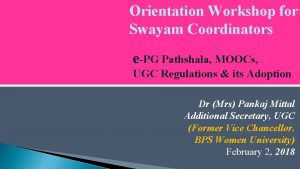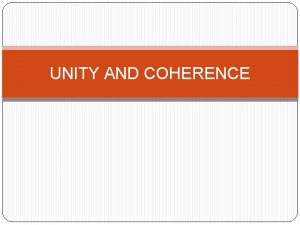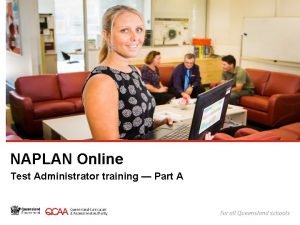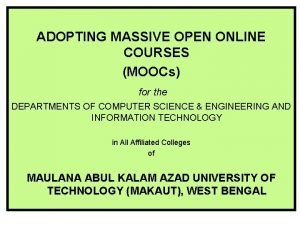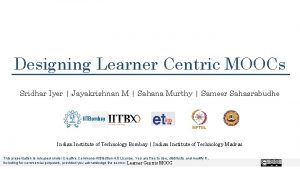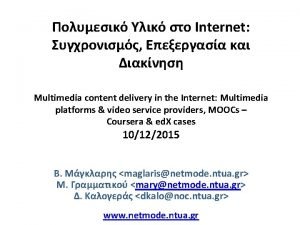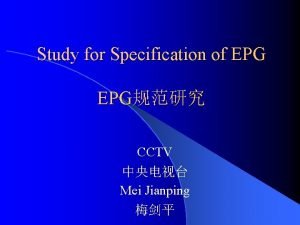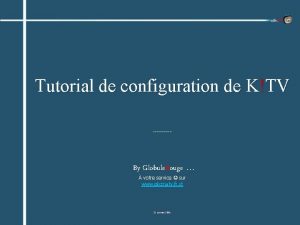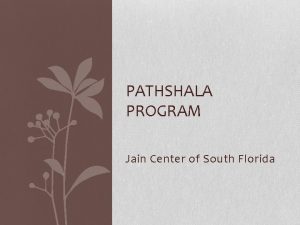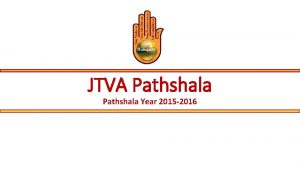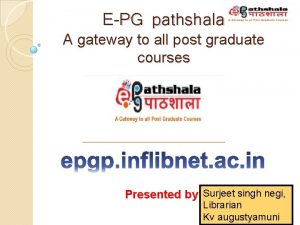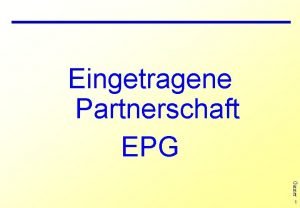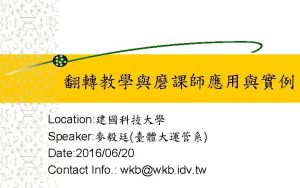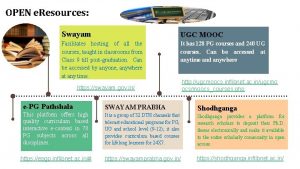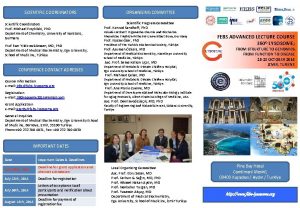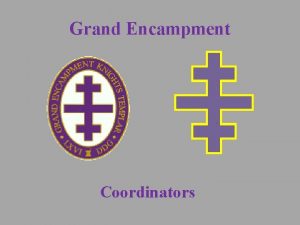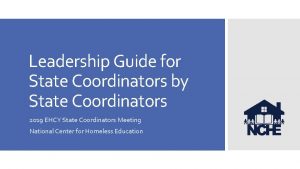Orientation Workshop for Swayam Coordinators ePG Pathshala MOOCs












- Slides: 12

Orientation Workshop for Swayam Coordinators e-PG Pathshala, MOOCs, UGC Regulations & its Adoption. Dr (Mrs) Pankaj Mittal Additional Secretary, UGC (Former Vice Chancellor, BPS Women University)

Information flow and Media Consumption Habits

MOOCs - A different educational space Boundary less Institute / University Massive – Large enrolment numbers Open - No mandatory qualifications – Open to all Online – Fully online Course - Structured course content is an online course aimed at unlimited participation and open access via the web. The basic philosophy of MOOCs is 3 A’s i. e. , Anytime, Anyone, Anywhere.

NATIONAL COORDINATORS National MOOCs Coordinator Sectors University Grants Commission (UGC) Non-Technology Programs NPTEL Technical/Engineering UG & PG degree programs Consortium for Educational Communication (An IUC of UGC) Non-Technology Under Graduate degree programs. IGNOU Diplomas and Certificates NCERT School Education from Class 9 th to 12 th. NIOS School Education from Class 9 th to 12 th. IIM Bangalore Management programs. NITTR, Chennai Teacher Training programs. Post Graduate Degree


Difference between e-content and MOOCs E-PG Pathshala (OER) E-PG Pathshala provides e-content in four quadrants. It can be accessed as Open Educational Resource (OER) where no teacher support/hand-holding for students is available. MOOCs has teacher-student groups where MOOC coordinator/teacher interacts with the learner. A learner can earn certificate/credit on successful completion of MOOCs course on SWAYAM.

Development of MOOCs • Two methods followed: – Repurposed from e PGP (63 uploaded on Swayam, 100 in pipe-line) – New MOOCs to be developed (100 in first year) • New MOOCs may be offered for - courses high in demand but expertise not available in majority of the universities (eg Electives). (Suggestions solicited from academia, students on UGC Website) �For core and generic papers, e-PG Pathshala to be used as OER

UGC (Credit Framework for Online Learning Courses through SWAYAM)8 Regulation, 2016 Learning Courses Issued on 19 th July 2016 Notification Online learning courses to SWAYAM to notify courses on be available on SWAYAM June 1 & Nov 1, every year Credit Transfer Choice of Courses on SWAYAM Up to 20% courses in a permitted for credit transfer Program can be on SWAYAM

Step by step procedure to be adopted by Universities for adopting 9 MOOCs on SWAYAM Step-1: Make Amendments Step-2: Select the Courses The University shall select the courses to be permitted for credit transfer through SWAYAM. (eg courses in high demand for which faculty is not available, elective courses or for supplementing teaching-learning process) while ensuring that physical facilities like laboratories, computer facilities, library etc. required for the course are made available free to the students in adequate measure. Step-4: Disseminate Information The University should widely disseminate information about selected courses to the students through faculty members, notice boards, student forums, workshops and university website etc. The University through their Competent Authority (EC, AC, BOS), should make amendments in their Ordinances, Rules, Regulations to incorporate provisions for transfer of credits for MOOCs courses as per UGC Regulations. Step-3: Designate Course Coordinator The University must designate a Course Coordinator/facilitator to guide the students throughout the course and to facilitate/conduct the Lab/Practical sessions/examinations.

Steps Continued… 10 Step-6: Evaluation The Host Institution shall evaluate the students registered for MOOCs courses based on discussion forums, quizzes, assignments, sessional and final examinations. The University to assist Host Institution in conducting the final examination. Step-8: Certificate On receipt of MOOCs completion certificate from Host Instt, the University to give equivalent credit weightage upto 20% for the credits earned through SWAYAM. No University shall refuse any student for credit mobility for courses earned through MOOCs. Step-5: Course Registration University to facilitate registration of students. Every student enrolled for the course in the University must register for the MOOCs course. Step-7: Marks of the Students The University shall incorporate the marks/grades communicated by the Host Institution in the final mark sheet of the student which counts for award of degree/diploma. However, the University shall evaluate the students for the practical/lab component and incorporate these marks/grades in the overall mark sheet of the student.

Outcome of the Project ü Addresses the problem of Access, Equity and Quality by addressing faculty shortage and lack of good quality faculty. ü The project would help the students and teachers to update their knowledge and skills, especially for those located in rural/backward/remote areas. ü The project would successfully bridge the digital divide and would help the nation move towards information-rich society.

Thanks for patient hearing pankajugc@gmail. com
 Epg pathshala
Epg pathshala Coherence and unity
Coherence and unity Naplan test administrator training
Naplan test administrator training Moocs makaut
Moocs makaut Designing learner-centric moocs
Designing learner-centric moocs Designing learner-centric moocs
Designing learner-centric moocs Community linkages and professional engagement importance
Community linkages and professional engagement importance Massive open online course
Massive open online course Same content
Same content Epg = mgh
Epg = mgh Comment definir le mode epg et regler le timeshift?
Comment definir le mode epg et regler le timeshift? Difference between ethnocentric and polycentric
Difference between ethnocentric and polycentric Bamse för de yngsta
Bamse för de yngsta
